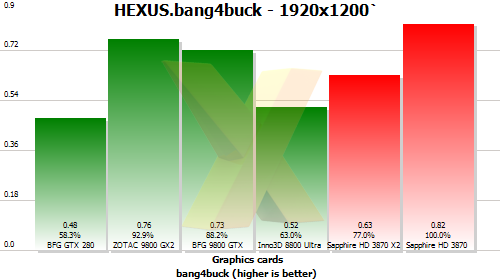HEXUS.bang4buck, temps, power-draw
HEXUS.bang4buck
In a rough-and-ready assessment of the cards' bang per buck, we've aggregated the 1,920x1,200 frame-rates for the four games, normalised them* and taken account of the cards' prices.
But there are more provisos than we'd care to shake a stick at. We could have chosen three different games, the cards' prices could have been derived from other sources and pricing tends to fluctuate daily.
Consequently, the table and graph below highlight a metric that should only be used as a yardstick for evaluating comparative performance with price factored in. Other architectural benefits are not covered, obviously.
| Graphics cards | BFG GeForce GTX 280 1024MiB | ZOTAC GeForce 9800 GX2 1024MiB | BFG GeForce 9800 GTX 512MiB | Inno3D GeForce 8800 Ultra 768MiB | Sapphire Radeon HD 3870 X2 1024MiB | Sapphire Radeon HD 3870 512MiB |
|---|---|---|---|---|---|---|
| Actual aggregate marks at 1,920x1,200 | 309.02 | 306.75 | 192.14 | 205.23 | 201.74 |
128.8 |
| Aggregate marks, normalised*, at 1,920x1,200 | 224.86 | 228.33 | 134.17 | 154.93 | 151.29 |
73.2 |
| Current pricing, including VAT | £469 | £299 | £185 | £299 (hard to find) | £239 | £89 |
| HEXUS.bang4buck score at 1,9200x1,200 | 0.479 | 0.764 | 0.725 | 0.518 | 0.633 |
0.822 |
| Acceptable frame rate (av. 60fps) at 1,920x1,200 | No (Crysis, LP) | No (Crysis, LP) | No (ET, Crysis, LP) | No (Crysis, LP) | No (Crysis, LP) | No (CoH, ET, Crysis, LP) |
* The normalisation refers to taking playable frame rate into account. Should a card benchmark at over 60 frames per second in any one game, the extra fps count as half. Similarly, should a card benchmark lower, say at 40fps, we deduct half the difference from its average frame rate and the desired 60fps, giving it a bang4buck score of 30 marks. The minimum allowable frame rate is 20fps but that scores zero.
As an example, should a card score 120fps we treat it as 90fps as only half the frame rate above 60fps is counted for the bang4buck - this is the formula: (120-((120-60)/2)). Similarly, should it score 30fps, we count it as only 15fps: (30+((30-60)/2)).
The reasoning behind such calculation lies with playable frame rates.
Should card A score 110fps in a benchmark and card B 160, then card B would otherwise receive an extra 50 marks in our bang4buck assessment, even though both cards produce perfectly playable frame rates and anything above 60fps is a bonus and not a necessity for most.
Similarly, without our adjustments, the aggregated bang4buck total for two very different cards would be identical if, in a further benchmark, card A scored a smooth 70fps and card B an unplayable 20fps. Both would win marks totally 180, yet the games-playing experience would be vastly different.
A more realistic (and useful) assessment would say that card A is better because it ran smoothly in both games - and that view would be accurately reflected in our adjusted aggregation, where card A would receive 150 marks (85+65) and card B 100 (100+0).
In effect, we're including a desired average frame rate, in this case 60, and penalising lower performance while giving frame rates higher than 60fps only half as much credit as those up to 60fps. If this doesn't make sense or you have issue with it, please hit the HEXUS community.
Here's the HEXUS.bang4buck graph at 1,920x1,200.

The graph divides the normalised score by the price.
The important bit
Our four benchmarks have shown that aggregate and normalised performance is generally similar to a GeForce 9800 GX2's. That's all well and good until you look at zero-day pricing for the BFG card.
We have it on good authority that it will retail for around £470, including VAT, or £170 dearer than the cheapest GX2.
The pricing, frankly, is silly. GeForce GTX 280 brings little new to the table other than pure grunt, so why should you pay much more for a single-GPU design? We'll go into the value aspect in our conclusion, but, until then, the graph, above, says it all.
Temperature musings
We perform our testing on an open test bed with a 120mm fan simulating case airflow.
| Graphics cards | BFG GeForce GTX 280 1024MiB | ZOTAC GeForce 9800 GX2 1024MiB | BFG GeForce 9800 GTX 512MiB | Sapphire Radeon HD 3870 X2 1024MiB | Sapphire Radeon HD 3870 512MiB |
|---|---|---|---|---|---|
| Ambient temperature | 21.5°C | 22°C | 21.5°C | 19°C | 20.5°C |
| Idle temperature | 47°C | 60°C | 52°C | 56°C | 55°C |
| Load temperature | 74°C | 80°C | 67°C | 80°C | 89°C |
| Ambient-to-load delta | 52.5°C | 58°C | 45.5°C | 61°C | 68.5°C |
The BFG GTX 280's cooler does remarkably well in keeping the hot-running GPU relatively cool under full load. It's quiet when doing it, too.
Power-draw
Power-draw was measured with the systems at idle and then with them running 3DMark 06's Canyon test at 1,920x1,200 4xAA, 16xAF.| Graphics cards | BFG GeForce GTX 280 1024MiB | ZOTAC GeForce 9800 GX2 1024MiB | BFG GeForce 9800 GTX 512MiB | Inno3D GeForce 8800 Ultra 768MiB | Sapphire Radeon HD 3870 X2 1024MiB |
|---|---|---|---|---|---|
| System wattage, idle | 127W | 174W | 144W | 140W | 137W |
| System wattage, load | 279W | 313W | 228W | 298W | 291W |
Contradicting the information provided by NVIDIA, the GeForce GTX 280 isn't particularly thirsty for a high-end card. We measured at-mains power-draw and found it to be more frugal than all but the GeForce 9800 GTX.
Of course, benchmarking different games will provide varying results, yet the 40W or so difference between GTX 280 and 9800 GX2 is hard to explain.
Note, too, that the GTX 280's idle power-draw is the lowest of the bunch, showing that the power-gating that NVIDIA has introduced really does work.









